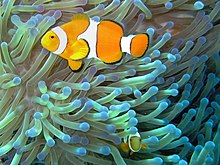
Back تعاون Arabic Kooperasiya Azerbaijani Kooperasyon BCL Кааперацыя Byelorussian Супрацоўніцтва BE-X-OLD Kooperacija (evolucija) BS Cooperació Catalan Spolupráce Czech Samarbejde Danish Kooperation German

Cooperation (written as co-operation in British English and, with a varied usage along time,[1] coöperation) takes place when a group of organisms works or acts together for a collective benefit to the group as opposed to working in competition for selfish individual benefit. In biology, many animal and plant species cooperate both with other members of their own species and with members of other species with whom they have (symbiotic or mutualistic) relationships.[2]
- ^ "coöperation - Accent marks in English?". groups.google.com - alt.usage.english. Newsgroup: alt.usage.english.
- ^ Kohn, Alfie (1992). No Contest: The Case Against Competition. Houghton Mifflin Harcourt. p. 19. ISBN 978-0-395-63125-6.